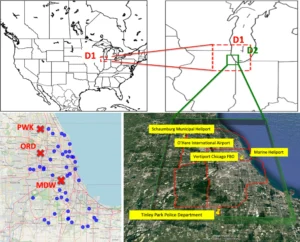
Researchers at the University of North Dakota (UND), a distinguished institution in the field of Unmanned Aircraft Systems (UASs), have unveiled a groundbreaking intelligent prediction system named “WindAware”. This system represents a significant step forward in the integration of UASs into the National Airspace System (NAS), especially over densely populated urban areas like Chicago, Illinois.
WindAware employs a sophisticated recurrent neural network to analyze existing ground-based wind data, offering near-term wind and turbulence forecasts. These forecasts, updated every 5 minutes and extending up to 6 hours, cover crucial parameters such as wind speed, direction, gusts, and eddy dissipation rate. Such data are vital for managing flight times, scheduling, precision tracking, battery life, and overall safety of UAS operations.
The uniqueness of WindAware lies in its approach to utilizing existing ground sensor data for predicting aerial conditions and in its focus on providing data specifically for flight corridors, thereby addressing bandwidth limits and the risk of information overload during operations. The system has been detailed in the “Neural Networks and Applications” journal.
Mounir Chrit, a research assistant professor at UND Aerospace, leads the project.
“WindAware is based on open-source, publicly accessible data. It is an affordable but efficient and scalable solution to support high-density, large-scale and complex autonomous UAS operations over highly-integrated automated networks over cities and protect people at the ground.” said Mounir Chrit.
The system’s reliability was validated against various datasets during lake-breeze events, which significantly influence Chicago’s weather, air quality, and environment. Chrit highlights the importance of the model’s accuracy during these events to ensure its reliability.
In the broader context of Advanced Air Mobility (AAM), the prediction of wind and turbulence is crucial for the safety and efficiency of missions ranging from emergency management to delivery and people transport. With companies like Amazon and Google Wing Aviation exploring urban drone delivery, the need for accurate, high-resolution weather predictions has become paramount. Traditional methods, such as LiDAR and radar, present challenges in terms of cost, maintenance, and operational limitations.
WindAware addresses these challenges by combining turbulence-resolving simulations with deep learning techniques, offering a promising solution for high-resolution, timely, and accurate wind and turbulence predictions along AAM routes. The system has been tested against traditional numerical weather prediction models and remote sensing instruments, showcasing its potential as a more scalable and operationally viable option.
Current efforts are focused on enhancing the model’s trustworthiness by adding multiple safeguards for reliability, robustness, and explainability. The team is conducting real flight tests to evaluate the system and gather feedback from operators, pilots, and beta-testers. This ongoing research and development effort underscores the potential of WindAware to significantly improve UAS operations in urban areas, marking a notable advancement in the field of UAS and AAM technologies.
Read more:
Miriam McNabb is the Editor-in-Chief of DRONELIFE and CEO of JobForDrones, a professional drone services marketplace, and a fascinated observer of the emerging drone industry and the regulatory environment for drones. Miriam has penned over 3,000 articles focused on the commercial drone space and is an international speaker and recognized figure in the industry. Miriam has a degree from the University of Chicago and over 20 years of experience in high tech sales and marketing for new technologies.
For drone industry consulting or writing, Email Miriam.
TWITTER:@spaldingbarker
Subscribe to DroneLife here.

